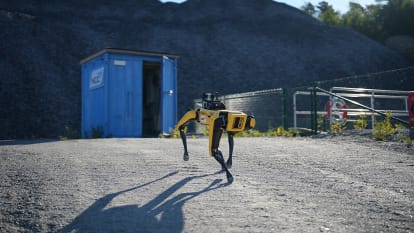Meet NiCCi – NCC’s robot dog
The AI robot dog – NiCCi – arrived at NCC in June 2021. Since then, she has worked with several construction projects. But what does a robot dog really do at a construction site and why did NCC decide to acquire a robot dog?
Today, many sectors use robotics to a very large extent. Despite this, a robot dog is a rare sight, particularly at a construction site.
“NCC has been working intensively with digitalization for a number of years. Our efforts in BIM and VDC have made it possible to take the next step, namely to purchase a robot dog. This is part of our journey toward a seamless flow of information and making more data-driven decisions,” says Christina Claeson Jonsson, Head of Research & Innovation, NCC.
One high-priority area of application for NCC is health and safety. Here, this type of robot can conduct duties referred to as the three Ds: Dirty, Dusty, Dull. Such duties include inspections of confined spaces or following blasting, when there is a risk of blast dust and falling rocks. This way, we reduce work environment risks for construction staff and create a safer construction site.
“We can already see many areas of application for NiCCi though it remains a journey of exploration where we are open to identifying new potential areas where she could be useful,” says Christina Claeson Jonsson.
Work methods and experiences
The work methods used by the robot dog enable the transfer of knowledge: what NiCCi does in one project is passed onto the next workplace. This leads to a build-up of knowledge. Her first assignment was at the Kineum project in Gothenburg, where NCC constructed a hotel and also its own office.
“We took NiCCi along with us to the construction site to see how construction workers reacted and studied how she acts when there are objects lying on the floor or obstacles in her way. We also tested “auto walk”, when she was left without an escort to navigate a pre-programmed route. Moreover, we carried out various types of scanning to create point clouds. A point cloud can then be translated into a space, such as a window. Based on this, we can see whether the window has been mounted in the right location using the right measurements through a comparison with the BIM model,” says Gustav Olsson, Lead VDC Developer, Group VDC.
NiCCi has been working in the Stockholm area on a civil engineering project since August 2022. The environment on this site is more difficult with porous surfaces that also lean. On muddy ground, NiCCi is like Bambi on slippery ice, and a study is therefore taking place to see the type of information that can be collected in these conditions.
“We are surprised every time we use NiCCi. Some things work perfectly while others grind to a halt. By taking small, systematic steps we will eventually be able to take a huge step forward,” says Andreas Villén, Head of VDC Infrastructure, Process and Production Development, NCC Infrastructure.

